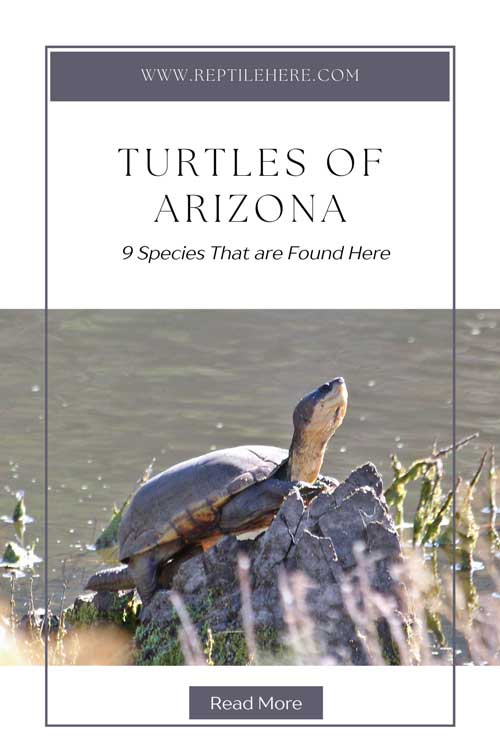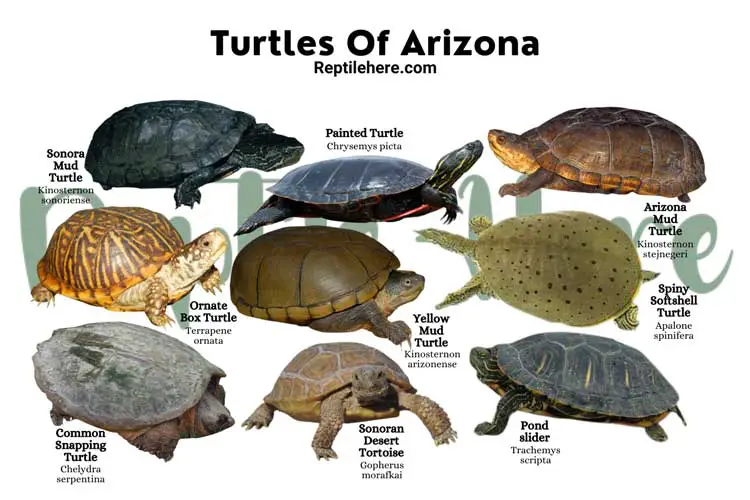Turtles Of Arizona – 9 Species That are Found Here
Arizona has an arid and semi-arid climate and is famous for its deserts, hot summers, and mild winters. In other words, it is a drier climate region. This means it doesn’t have the perfect living conditions for most turtle species compared to other states.
Nonetheless, it is home to some turtle species. These include mud turtles, box turtles, and even freshwater/aquatic turtles.
Our list below discusses the 9 types of turtle species found in Arizona, including the basic information you need to know about each of them like their appearance, size, lifespan, diet, conservation status, and more.
9 Types Of Turtles Of Arizona
Contents
1. Arizona Mud Turtle
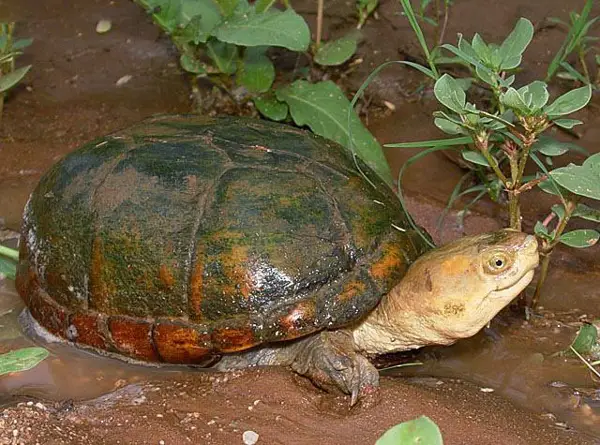
- Scientific name: Kinosternon stejnegeri
- Common name: Arizona Mud Turtle, Mud Turtle
- Family: Kinosternidae
- Size: 5 to 7 inches
- Lifespan: 30 to 50 years
- Conservation status: Least Concern
This Arizona mud turtle is a species of mud turtle and is notorious for letting out a foul smell as a defensive mechanism if it feels threatened.
It can be found in various waterbodies in Arizona, including rivers, creeks, lakes, and ponds.
An adult mud turtle has its outer shell, or carapace, having brown coloration with yellow hints. The lower side of the shell is usually yellow or yellow-brown. The shell of these turtles usually has an oval shape.
Skin color is usually the same as that of the upper shell, except for the yellow or yellow-brown lower side of the shell.
Arizona mud turtles are omnivorous, meaning they feed on both insects and vegetation. Various foods making up their diet include snails, insects, fish, fruits, and other types of vegetation.
Note that the Arizona mud turtle tends to burrow underground where there’s mud when the weather gets hot. This is to help cool off their bodies. It also hibernates underground to survive the cold winter weather.
2. Sonora Mud Turtle
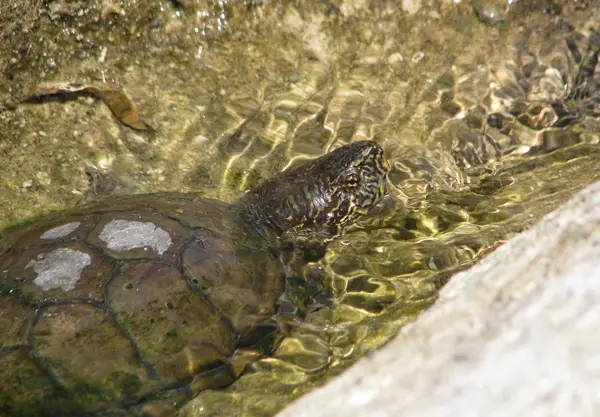
- Scientific name: Kinosternon sonoriense
- Common name: Sonora Mud Turtle, Mud Turtle
- Family: Kinosternidae
- Size: 5 to 7 inches
- Lifespan: 30 to 50 years
- Conservation status: Near threatened
This turtle likes spending most of its time in water and is fond of creeks, streams, and even stock ponds in Arizona.
It is a pretty isolated species and won’t be found in many areas apart from Arizona, Mexico, and New Mexico.
A Sonora mud turtle is identified by its brown skin with yellow lines. The upper shell is olive-brown in color and has keels on it.
Similar to most other mud turtles, these turtles are omnivorous and like feeding on small insects and animals as well as vegetation.
Although this turtle species was once widespread, its range and population have been on the decline owing to habitat loss due to human intervention.
For this reason, the Sonora mud turtle in Arizona has been labeled a “Near Threatened” species and is under special protection.
Thus, spotting one in the wild in Arizona will mean you’re quite lucky. And we caution you to be extra careful in your observations!
3. Spiny Softshell Turtle
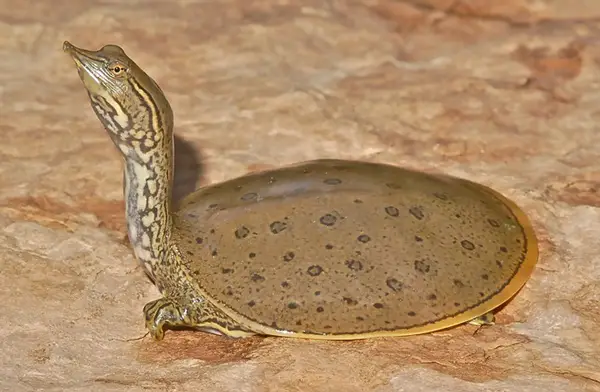
- Scientific name: Apalone spinifera
- Common name: Spiny Softshell Turtle
- Family: Trionychidae
- Size: 5 to 9 inches (males), 12 to 20 inches (females)
- Lifespan: 30 to 70 years
- Conservation status: Least Concern
The Spiny softshell turtle is a medium-to-large freshwater species that lives in Arizona’s lakes, streams, and rivers with muddy or sandy bottoms and little or no vegetation.
Female spiny softshell turtles are usually larger than males. And unlike other turtles, this species has a flexible, leather-like carapace that’s extremely rounded and flattened. The shell color can be olive grey or yellow-brown. Just like other softshell turtles, this species also has a snorkel-like snout.
The young ones feature well-defined round spots that are easily visible on the shell (though these spots become invisible as they transition to adulthood).
Spiny softshell turtles in Arizona tend to eat anything they find in the waters including crayfish, insects, small fish, and so on. They hunt by burying themselves in the mud or sand while keeping their head uncovered to grab food as it swims by.
These turtles are also able to breathe underwater by taking in oxygen through their throat skin. This is a useful adaptation given that they don’t spend a lot of time out of water.
Other adaptations of these Arizona turtles include webbed feed, long claws, and extremely flat shells that enable them to quickly swim away from predators and burry in the muddy bottom of the waters they reside in.
4. Yellow Mud Turtle
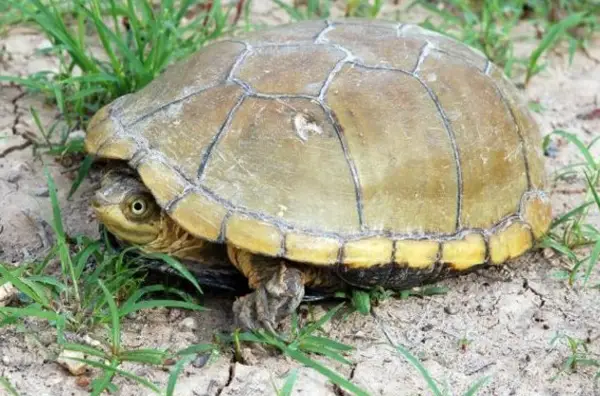
- Scientific name: Kinosternon arizonense
- Common name: Yellow Mud Turtle, Mud Turtle
- Family: Kinosternidae
- Size: 4-5 inches
- Lifespan: 40 years
- Conservation status: Least concern
The Yellow mud turtle is a species native to Arizona and prefers living in any waterbody you can come across in Arizona state.
Possible places you can find it includes muddy pools, cattle tanks, irrigation ditches, sewer drains, and even cisterns!
This turtle will spend more time on land migrating to new water sources and is never picky about where it can stay.
It has a flattened upper shell with colors varying from brown to black or olive. It also features dark brown edges around its scutes. The skin color is usually olive.
Males have a sharp or horny end as a distinctive feature.
This Arizona yellow mud turtle is omnivorous like any other mud turtle. Its diet is made up of a variety of foods including tadpoles, leeches, crayfish, fairy shrimp, and fish.
It will also eat frogs, slugs, and snails. And as an opportunistic feeder, it will also eat decaying animal and plant matter.
Also read: Turtle Of Alaska
5. Ornate Box Turtle
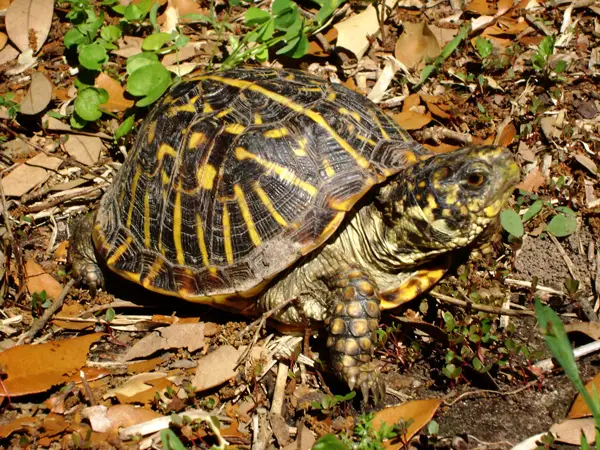
- Scientific name: Terrapene ornata
- Common name: Ornate Box Turtle, Western Box Turtle
- Family: Emydidae
- Size: 5 to 7 inches
- Lifespan: 40 to 60 years
- Conservation status: Near Threatened
Ornate box turtles are present in Arizona and are recognized by the beautiful pattern on their carapace. This eye-pleasing pattern is sometimes referred to as a starburst pattern.
Their skin is grey and may feature yellow or white spots. Male heads occasionally feature green color.
Though there exists little distinction between the males and females of these Arizona box turtles, males are generally smaller than females.
During hot weather, this turtle requires water to help regulate its body temperature.
The Arizona species of turtle are known to hibernate in burrows during cold weather. They’re also capable of surviving in frozen soils for several days.
Being omnivorous in nature, and opportunistic feeders, these turtles will gladly feed anything available to them in their habitat or what’s abundant in a given season. They have been observed eating fruits, vegetables, grasshoppers, and various other insects.
Also, keep in mind that these box turtles are pretty shy and don’t like being handled excessively. As such, you may want to avoid approaching them suddenly while in the wild in Arizona.
6. Painted turtle
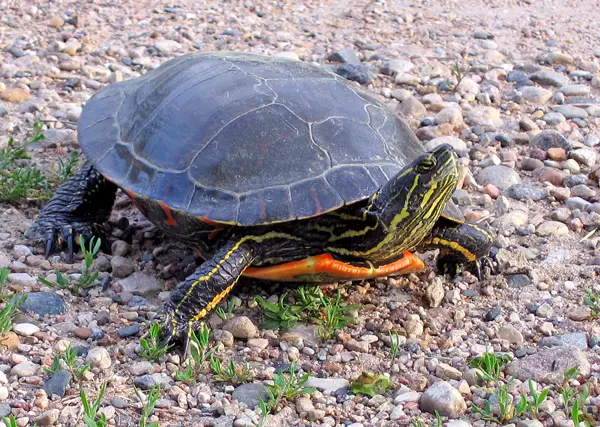
- Scientific name: Chrysemys picta
- Common name: Painted Turtle
- Family: Emydidae
- Size: 4 to 6 inches
- Lifespan: 30 to 50 years
- Conservation status: Least Concern
The painted turtle is one of the most recognizable turtle species in Arizona, thanks to its beautiful and unique coloring. The bright reds and yellow-green markings on its shell, head, and limbs are no doubt a beauty to behold!
Note that this species has up to 4 subspecies (Eastern, Western, Midland, and Southern species). And although they may slightly differ in appearance, they all have similar behavior.
The painted turtle species in Arizona has been observed to live near water bodies with minimal movement. Examples include marshes, ponds, slow-moving streams with sandy/muddy bottoms, small lakes, etc.
They also prefer areas with aquatic plants in plenty as they make their primary food source in the wild.
One interesting fact about these Arizona turtles is their ability to hold their breath for up to 30 hours when inside temperate water. Moreover, they’re capable of standing dominant in freezing cold waters for up to 4 months.
Unfortunately, it’s not easy to establish the population of these turtles in Arizona. This is because most people who pet them end up releasing them back into the wild.
This contributes to an ever-expanding range plus unstable reproduction rates for these turtles.
7. Pond slider
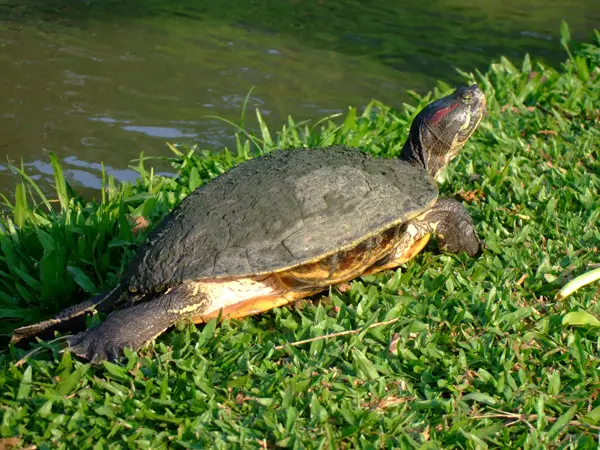
- Scientific name: Trachemys scripta
- Common name: Pond slider
- Family: Emydidae
- Size: 7 to 12 inches
- Lifespan: 30 to 40 years
- Conservation status: Least Concern
Pond sliders is a term used to refer to 3 sub-species of turtles namely yellow belly sliders, red-eared sliders, and Cumberland sliders. For all these 3 subspecies, the males are usually smaller than the females and have thicker tails.
Baby pond sliders are characterized by green shells and a yell-green or dark green skin color. But this color fades as they age. Males, in particular, tend to get darker. Their legs, neck, and head feature yellow marks and stripes alongside this dark appearance.
Red-eared sliders are often confused with painted turtles due to red markings at the jawline plus brightly colored stripes. However, their carapace is more rounded and helmet-like compared to those of painted turtles. Sliders are also bigger than painted turtles in captivity.
Pond sliders in Arizona prefer living in slow-moving waters such as rivers, ponds, lakes, and swamps. They also prefer habitats with muddy bottoms.
As for the diet, pond sliders are omnivorous but they’re more into eating vegetation in their adult age. The young ones are more carnivorous and will eat meat more.
People commonly purchase this turtle species in Arizona as a pet but later on release it into the world when it becomes difficult to take care of or gets too large. But this isn’t a good practice as it can cause pressure on the natural ecosystem.
8. Common Snapping Turtle
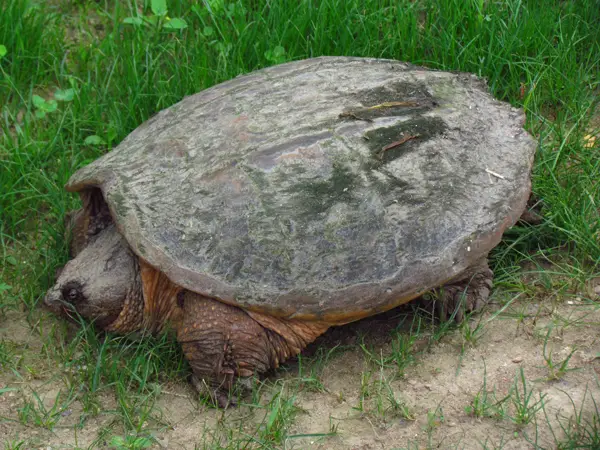
- Scientific name: Chelydra serpentina
- Common name: Snapping Turtle
- Family: Chelydridae
- Size: 8 to 18 1/2 inches
- Lifespan: 30 to 50 years or more
- Conservation status: Least Concern
Common snapping turtles are also found in Arizona. An average adult is pretty large and has a shell length of 18½ inches long.
This species has a chunky head, a long tail, and large webbed feet. The shell color is black or olive and has no distinct pattern. These Arizona snapping turtles are known for their powerful jaws—they’re so strong that these turtles eat other turtles!
You’ll find them in waterbodies with muddy bottoms. Examples include marshes, ponds, lakes, rivers, and even shallow streams. They generally prefer waters with aquatic vegetation in plenty and foods such as fish, frogs, birds, etc.
These Arizona turtles generally show docile behavior but can get quite aggressive if taken out of water. The best way to calm it is to take it back to the waters, where it feels safe.
9. Sonoran Desert Tortoise
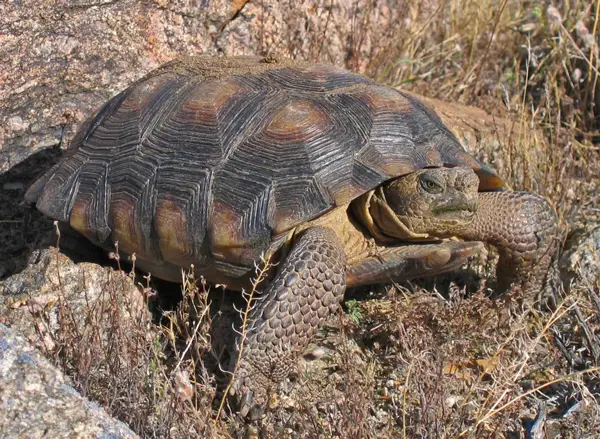
- Scientific name: Gopherus morafkai
- Common name: Sonoran Desert tortoise
- Family: Testudinidae
- Size: 6 to 14 inches
- Lifespan: 60 years
- Conservation status: Vulnerable
The Sonoran Desert tortoise lives in the Arizona arid climate and is capable of withstanding little rain and intense heat.
It prefers areas with firm ground where it can build burrows and use the rocks as shelter. A typical burrow for this desert tortoise has a unique half-moon-shaped opening.
This Arizona desert tortoise has been observed to spend most of its life underground and only comes out to the surface during foraging or breeding. This helps it conserve water and energy.
The terrestrial tortoise is herbivorous and eats stems, leaves, and flowers.
One great capability of this tortoise is that it can withstand ground temperatures up to 140 degrees Fahrenheit—making it one of the few species capable of withstanding extreme heat and lack of rain in the Death Valley!
The desert species of Arizona is labeled as an “indicator species.” This means it is used to show the health of the ecosystem by observing its population health.
Unfortunately, the Sonoran Desert turtle population is on a downward trend throughout its habitat.
This has been attributed to various issues including mining, expansion, natural predation, and destruction of their burrows by off-road vehicles.
Related: Turtles in Vermont
Conclusion
These are the 9 types of turtle species found in Arizona. While the state may not be home to many turtles, it still has its share of species that are native to the region.
The reason for fewer species of turtles in Arizona is unfavorable living conditions, characterized by an arid and semi-arid climate. Not many turtles can survive the dry climate the region receives.
Nonetheless, Arizona remains home to the native mud turtles, box turtles, and even freshwater/aquatic turtles we have discussed in the above guide.
